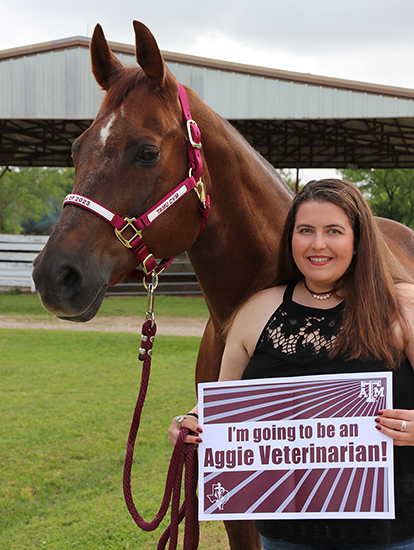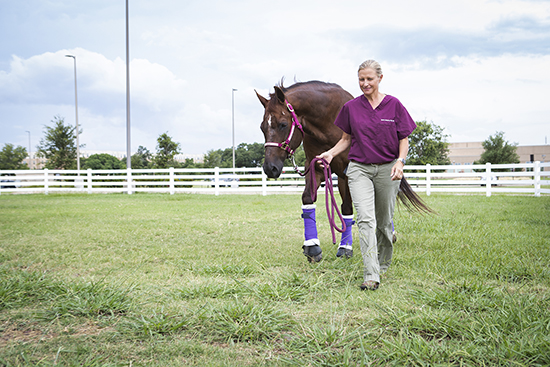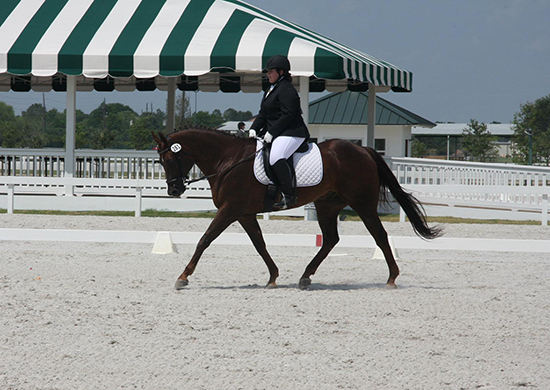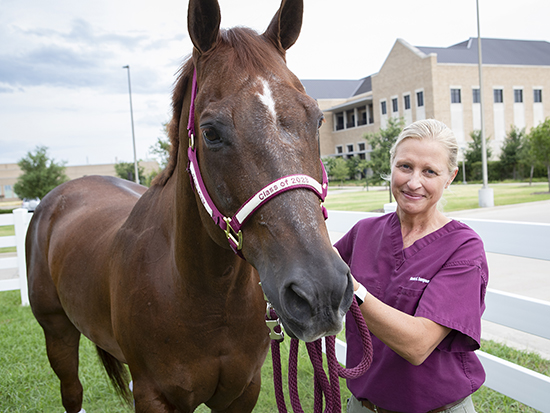Texas A&M LAH Gives Long-Term Patient Hope Using Stem Cell Therapy
Story by Megan Myers, CVMBS Communications

Many veterinarians and staff members at the Texas A&M Large Animal Hospital (LAH) recognize Santana Bening. The 24-year-old Quarter Horse has been a patient since 2015 and for several years now has been visiting every five weeks to receive specialty shoes and other treatments for injured tendons in his front feet.
Some also know Santana by his owner, Chloe Bening, a second-year veterinary student at the Texas A&M College of Veterinary Medicine & Biomedical Sciences (CVM).
Chloe got Santana when they were both 11 years old, and the two immediately became best friends. Together, they participated in American Quarter Horse Association (AQHA) all-around events and dressage, competed nationally, and took home the AQHA Year-End High Point in Youth first-level dressage award in 2013.
When Santana developed a severe lameness of his front right foot in August 2016, he was subsequently retired from his show career. Chloe and her parents brought him to the LAH, where he was seen by Dr. Sarah Sampson, a clinical assistant professor of equine sports medicine and imaging.
“Santana was so lame when we first saw him that the only way we could get him comfortable was to put his leg in a bandage cast so that he didn’t have any significant movement of that limb,” Sampson said.
Following an ultrasound and MRI, Sampson determined that Santana had severe deep flexor tendon injuries in both of his front feet, with the right foot being more painful at the time. This tendon damage was partially caused by a degenerative process commonly seen in his breed and repetitive strain over his long show career.
Even though the Benings knew they had a long, expensive road ahead of them to heal Santana, they were determined to do whatever was necessary to get him happy and pain-free.

Starting With Stem Cells
After his diagnosis and a short period of rest, Santana began treatment with a series of stem cell perfusions in his front feet.
Stem cell perfusions work by injecting stem cells cultured from bone marrow, in this case taken from Santana’s sternum, into the affected limb. With their anti-inflammatory properties and their ability to signal to other cells in the body, stem cells improve the horse’s ability to self-heal.
According to Sampson, stem cells are a relatively common treatment at the LAH, especially in the sports medicine service.
“Between all of the services at the hospital, I think there’s usually a horse in one of the services receiving stem cell treatment,” Sampson said. “Because we have a lab of our own at Texas A&M, it’s pretty easy for us to get bone marrow and do the culturing.”
Stem cells are most frequently used to treat injured tendons and ligaments in horses but are also becoming a more common option for cartilage tears or fractures in joints. Equine veterinarians are hopeful that with time, even more possibilities will arise.
“There’s a lot of research that still needs to be done,” Sampson said. “The hope is that we will be able to say, ‘This is a lesion that we can definitely help with stem cells,’ and to be able to focus in on where we truly can be the most helpful.”

Slow And Steady
While receiving stem cell treatments, Santana also began visiting Jason Maki, the LAH’s in-house farrier, whom Santana has seen every five weeks since for shoe adjustments. He was first fitted with thick, protective shoes called clogs that kept his heels elevated to reduce the pain in his feet and allow the tendons to heal, before gradually transitioning to shoes with a large heel wedge.
To protect his tendons, the Benings no longer ride Santana but still keep him busy practicing showmanship, which involves leading a horse through a pattern of walking, trotting, backing up, and pivoting.
“He really loves to stay competition-ready. He likes to be all shaved and look like a show horse,” Chloe said. “Besides that, he gets hand grazed and turned out in a small turnout, so he can’t hurt himself but is big enough that he can walk, trot, lope, and mess around. He’s living the good retired life.”
In addition to the talented veterinarians and staff members who have contributed to Santana’s healing journey, Sampson largely credits the Benings for his success.
“The Benings are those clients who do everything we tell them to do better than we could probably do it ourselves,” Sampson said. “At one point, his feet needed to be iced 24 hours a day, and they were paying people to go to the barn where he was boarded and ice him through the night. That’s what helps us treat animals the best, when the owners do exactly what you say.”

At Home In College Station
Luckily, Santana doesn’t mind the drive from Katy to College Station every five weeks, mainly because it gets him an extra visit with Chloe.
“As soon as mom pulls up the trailer at the barn and says, ‘You ready to go see Chloe?’ he will drag her to the trailer and jump right in,” Chloe said. “He loves to see all of the veterinary students, so he walks in there like he owns the place.”
Being a CVM student, Chloe has the extra benefit of being able to know the “behind-the-scenes” of Santana’s care and studying under the faculty members, like Sampson, who treat him.
“It feels like a group effort to take care of him at this point because everybody’s seen him for so long,” she said. “It’s awesome because I know that they’re taking care of him and I can trust them; I know that they’re always there watching him. It’s just so nice to know that they care so much for him.”
###
For more information about the Texas A&M College of Veterinary Medicine & Biomedical Sciences, please visit our website at vetmed.tamu.edu or join us on Facebook, Instagram, and Twitter.
Contact Information: Jennifer Gauntt, Director of CVM Communications, Texas A&M College of Veterinary Medicine & Biomedical Sciences; jgauntt@cvm.tamu.edu; 979-862-4216


